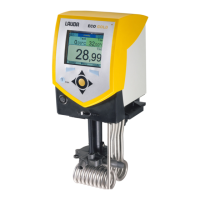
Do you have a question about the Lauda E 4 G and is the answer not in the manual?
| Brand | Lauda |
|---|---|
| Model | E 4 G |
| Category | Thermostat |
| Language | English |
Explains danger, warning, caution, and notice symbols and their meanings.
Provides general safety guidelines for operating the device and handling electrical hazards.
Details specific safety precautions for using the thermostat and handling heat transfer liquids.
Defines the responsibilities of the operator regarding personnel and device usage.
Provides instructions for assembling and positioning the device, including safety warnings.
Explains how to connect external consumers and mount the pump connection set.
Details the procedure for filling and emptying the device with heat transfer liquid.
Discusses approved heat transfer liquids, cooling water quality, and suitable hoses.
Explains how to switch on the device and what to expect during startup.
Explains the meaning of alarms, warnings, and error messages displayed by the thermostat.
Details the overtemperature protection mechanism, alarms, and checking procedures.
Describes the low liquid level alarm, its causes, and checking procedures.
Details the procedure for cleaning the device, including safety precautions.
Explains how to inspect and renew the heat transfer liquid.
Provides instructions for cleaning air-cooled and water-cooled condensers.
Offers troubleshooting guidance for common device faults and their remedies.
Provides contact information for service and ordering replacement parts.
Guides on how to reset all device settings or specific parameters to factory defaults.
Guides on correcting internal temperature display deviations using offset calibration.
Describes how to restore factory settings for the internal temperature sensor calibration.
Lists and explains specific alarm codes related to device safety and operation.
Lists and explains warning codes indicating non-safety-relevant device status.
Guides on activating external control using an external Pt100 sensor.
Details how to apply an offset value to the temperature using an external sensor.
Explains how to create, edit, insert, and delete program segments.
